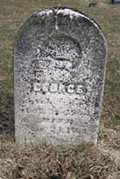NAVIGATION
SETTLEMENT | PEOPLE | MAP | RESEARCH | PORTER REA | ABOUT CEMETERIES
 Fading history
Fading history
Cemeteries are important sites of historical records. Marble was used for headstones in the 1800s in Indiana. Marble can be eroded away by acid rain. It is rain that has mixed with gases in the atmosphere. The gases come from our industries and automobiles. The effects of acid rain are quite visible here. Some stones that were easily readable in the 1980s now aren’t. Most headstones today are granite. It does not react with acid rain. Mosses and lichens also can deteriorate stones. These can be cleaned off by trained professionals. They use special detergents and tools. Untrained people should not clean an old grave marker. They may do more damage than good.
Did you know?
- The term cemetery comes from a Greek word. It meant sleeping place. The term became widely used in the 1800s. The older term was graveyard.
- Cemeteries are frequently laid out with the graves facing to the east. Many religions place importance on the rising sun.
- A large family marker may mark the family plot. A plot was typically eight individual graves. Smaller stones were used as headstones.
- A low rail around the edge may mark the plot.
- A headstone is placed at the head of the grave.
- A footstone may be at the foot of the grave.
- A 19th century headstone may contain, from top to bottom: an image chosen for its symbolism; the deceased’s name; the relationship of the deceased to the man of the family; the date of birth; the date of death; age at death in years, months and days; and an epitaph.
- Footstones frequently only had the deceased’s initials on them.
- The deceased is placed in a coffin. It is sometimes called a casket. The coffin is then placed in a vault. The purpose of the vault is to protect the casket. It keeps the ground from settling over the grave. Several of the older graves did not use vaults. There you can see where the ground has settled.
Symbolism
Symbols were used to represent an idea or belief. Symbols were commonly used in 19th century cemeteries. This slideshow displays common ones from Porter Rea Cemetery.
<< 6
